Experimental Investigation of Reynolds Number and Spring Stiffness Effects on Vortex-Induced Vibration Driven Wind Energy Harvesting Triboelectric Nanogenerator
Abstract
1. Introduction
2. Materials and Methods
3. Results
3.1. Smoke Wire Visualization Experiment of the SC-TENG
3.2. Vibration Characteristics of the SC-TENG
3.3. Output Performance of the SC-TENG
3.4. Demonstration Application of the SC-TENG
4. Conclusions
Author Contributions
Funding
Institutional Review Board Statement
Informed Consent Statement
Data Availability Statement
Acknowledgments
Conflicts of Interest
Appendix A
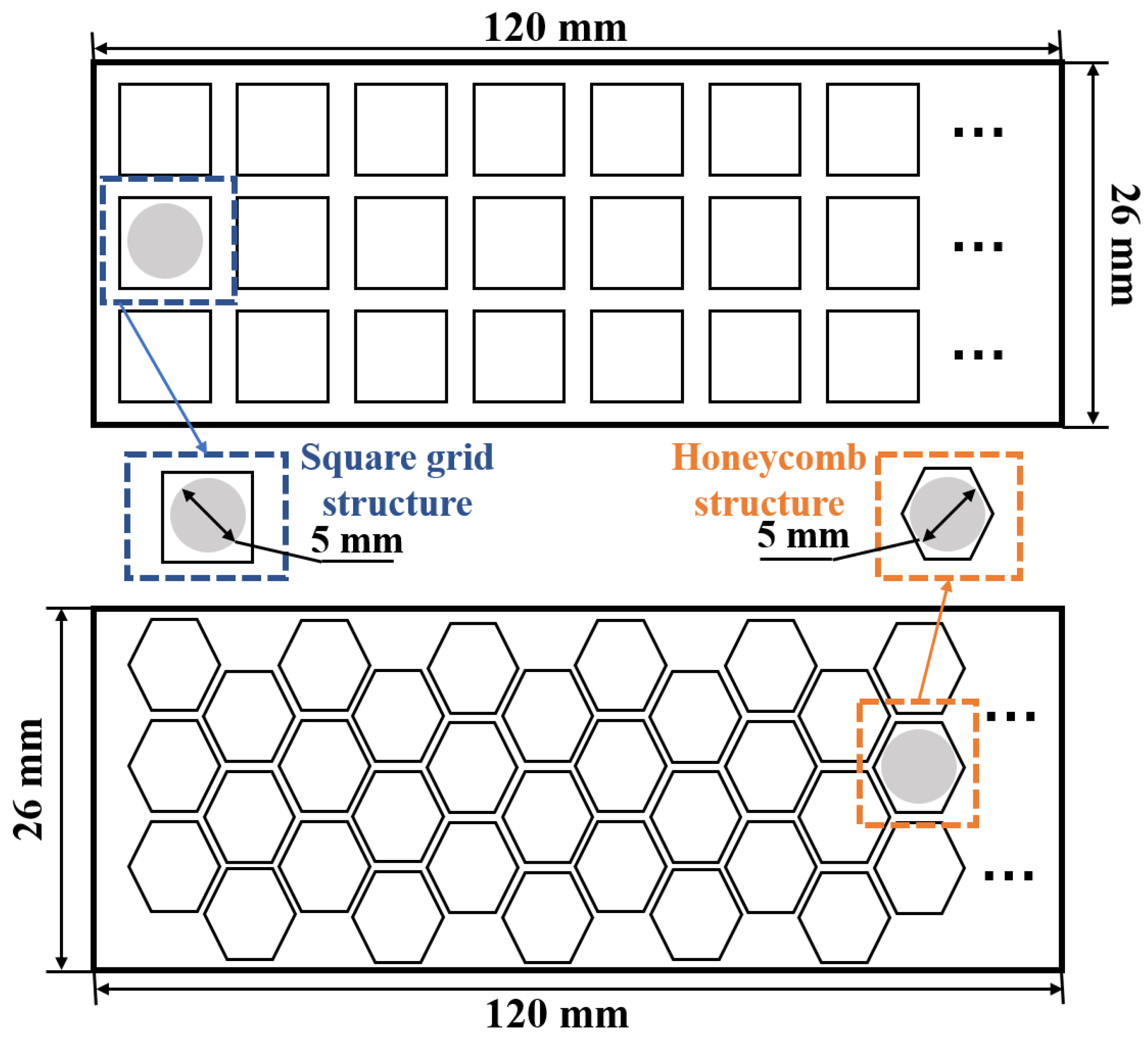



References
- Hu, C.; Pu, Y.; Yang, F.; Zhao, R.; Alrawais, A.; Xiang, T. Secure and Efficient Data Collection and Storage of IoT in Smart Ocean. IEEE Internet Things J. 2020, 7, 9980–9994. [Google Scholar] [CrossRef]
- Ramasur, D.; Hancke, G.P. A wind energy harvester for low power wireless sensor networks. In Proceedings of the Instrumentation and Measurement Technology Conference (I2MTC), Graz, Austria, 13–16 May 2012; pp. 2623–2627. [Google Scholar]
- Horn, J.W.; Arnett, E.B.; Kunz, T.H. Behavioral Responses of Bats to Operating Wind Turbines. J. Wildlife Manag. 2008, 72, 123–132. [Google Scholar] [CrossRef]
- Orrego, S.; Shoele, K.; Ruas, A.; Doran, K.; Caggiano, B.; Mittal, R.; Kang, S.H. Harvesting ambient wind energy with an inverted piezoelectric flag. Appl. Energ. 2017, 194, 212–222. [Google Scholar] [CrossRef]
- Ackermann, T.; Soder, L. Wind energy technology and current status: A review. Renew. Sust. Energ. Rev. 2000, 4, 315–374. [Google Scholar] [CrossRef]
- Wang, J.; Zhou, S.; Zhang, Z.; Yurchenko, D. High-performance piezoelectric wind energy harvester with Y-shaped attachments. Energy Convers. Manag. 2019, 181, 645–652. [Google Scholar] [CrossRef]
- Vu, D.; Nguyen, V.; Dinh, T.; Huy, V. Wind tunnel and initial field tests of a micro generator powered by fluid-induced flutter. Energy Sustain. Dev. 2016, 33, 75–83. [Google Scholar]
- Priya, S.; Chen, C.T.; Fye, D.; Zahnd, J. Piezoelectric Windmill: A Novel Solution to Remote Sensing. Jpn. J. Appl. Phys. 2005, 44, L104. [Google Scholar] [CrossRef]
- McCarthy, J.M.; Deivasigamani, A.; John, S.J.; Watkins, S.; Coman, F.; Petersen, P. Downstream flow structures of a fluttering piezoelectric energy harvester. Exp. Therm. Fluid Sci. 2013, 51, 279–290. [Google Scholar] [CrossRef]
- Wang, Z.L.; Jiang, T.; Xu, L. Toward the blue energy dream by triboelectric nanogenerator networks. Nano Energy 2017, 39, 9–23. [Google Scholar] [CrossRef]
- Wang, Y.; Wang, J.; Xiao, X.; Wang, S.; Phan, T.K.; Dong, J.; Mi, J.; Pan, X.; Wang, H.; Xu, M. Multi-functional wind barrier based on triboelectric nanogenerator for power generation, self-powered wind speed sensing and highly efficient windshield. Nano Energy 2020, 73, 104736. [Google Scholar] [CrossRef]
- Wang, Y.; Liu, X.; Wang, Y.; Wang, H.; Wang, H.; Zhang, S.L.; Zhao, T.; Xu, M.; Wang, Z.L. Flexible Seaweed-Like Triboelectric Nanogenerator as a Wave Energy Harvester Powering Marine Internet of Things. ACS Nano 2021, 15, 15700–15709. [Google Scholar] [CrossRef]
- Liu, L.; Guo, X.; Lee, C. Promoting smart cities into the 5G era with multi-field Internet of Things (IoT) applications powered with advanced mechanical energy harvesters. Nano Energy 2021, 88, 106304. [Google Scholar] [CrossRef]
- Wang, Y.; Hu, Z.; Wang, J.; Liu, X.; Shi, Q.; Wang, Y.; Qiao, L.; Li, Y.; Yang, H.; Liu, J.; et al. Deep Learning-Assisted Triboelectric Smart Mats for Personnel Comprehensive Monitoring toward Maritime Safety. ACS Appl. Mater. Interfaces 2022, 14, 24832–24839. [Google Scholar] [CrossRef] [PubMed]
- Wang, H.; Zhu, C.; Wang, W.; Xu, R.; Chen, P.; Du, T.; Xue, T.; Wang, Z.; Xu, M. A Stackable Triboelectric Nanogenerator for Wave-Driven Marine Buoys. Nanomaterials 2022, 12, 594. [Google Scholar] [CrossRef] [PubMed]
- Seo, J.; Hajra, S.; Sahu, M.; Kim, H.J. Effect of cilia microstructure and ion injection upon single-electrode triboelectric nanogenerator for effective energy harvesting. Mater. Lett. 2021, 304, 130674. [Google Scholar] [CrossRef]
- Hajra, S.; Panda, J.; Swain, J.; Kim, H.-G.; Sahu, M.; Rana, M.K.; Samantaray, R.; Kim, H.J.; Sahu, R. Triazine skeletal covalent organic frameworks: A versatile highly positive surface potential triboelectric layer for energy harvesting and self-powered applications. Nano Energy 2022, 101, 107620. [Google Scholar] [CrossRef]
- Wang, Y.; Yang, E.; Chen, T.; Wang, J.; Hu, Z.; Mi, J.; Pan, X.; Xu, M. A novel humidity resisting and wind direction adapting flag-type triboelectric nanogenerator for wind energy harvesting and speed sensing. Nano Energy 2020, 78, 105279. [Google Scholar] [CrossRef]
- Wang, Y.; Yu, X.; Yin, M.; Wang, J.; Gao, Q.; Yu, Y.; Cheng, T.; Wang, Z.L. Gravity triboelectric nanogenerator for the steady harvesting of natural wind energy. Nano Energy 2021, 82, 105740. [Google Scholar] [CrossRef]
- Bian, Y.; Jiang, T.; Xiao, T.; Gong, W.; Cao, X.; Wang, Z.; Wang, Z.L. Triboelectric Nanogenerator Tree for Harvesting Wind Energy and Illuminating in Subway Tunnel. Adv. Mater. Technol. 2018, 3, 1700317. [Google Scholar] [CrossRef]
- Zheng, H.; Zi, Y.; He, X.; Guo, H.; Lai, Y.C.; Wang, J.; Zhang, S.L.; Wu, C.; Cheng, G.; Wang, Z.L. Concurrent Harvesting of Ambient Energy by Hybrid Nanogenerators for Wearable Self-Powered Systems and Active Remote Sensing. ACS Appl. Mater. Interfaces 2018, 10, 14708–14715. [Google Scholar] [CrossRef]
- Kim, D.; Tcho, I.-W.; Choi, Y.-K. Triboelectric nanogenerator based on rolling motion of beads for harvesting wind energy as active wind speed sensor. Nano Energy 2018, 52, 256–263. [Google Scholar] [CrossRef]
- Ren, X.; Fan, H.; Wang, C.; Ma, J.; Li, H.; Zhang, M.; Lei, S.; Wang, W. Wind energy harvester based on coaxial rotatory freestanding triboelectric nanogenerators for self-powered water splitting. Nano Energy 2018, 50, 562–570. [Google Scholar] [CrossRef]
- Wang, J.; Geng, L.; Ding, L.; Zhu, H.; Yurchenko, D. The state-of-the-art review on energy harvesting from flow-induced vibrations. Appl. Energ. 2020, 267, 114902. [Google Scholar] [CrossRef]
- Sun, W.; Ding, Z.; Qin, Z.; Chu, F.; Han, Q. Wind energy harvesting based on fluttering double-flag type triboelectric nanogenerators. Nano Energy 2020, 70, 104526. [Google Scholar] [CrossRef]
- Wang, S.; Mu, X.; Yang, Y.; Sun, C.; Gu, A.Y.; Wang, Z.L. Flow-Driven Triboelectric Generator for Directly Powering a Wireless Sensor Node. Adv. Mater. 2015, 27, 240–248. [Google Scholar] [CrossRef] [PubMed]
- Phan, H.; Shin, D.; Sang, H.; Tae, Y.; Han, P.; Kim, G.; Kim, H.; Kim, K.; Hwang, Y.; Hong, S. Aerodynamic and aeroelastic flutters driven triboelectric nanogenerators for harvesting broadband airflow energy. Nano Energy 2017, 33, 476–484. [Google Scholar] [CrossRef]
- Quan, Z.; Chang, B.; Tao, J.; Wang, Z.L. Robust Thin Films-Based Triboelectric Nanogenerator Arrays for Harvesting Bidirectional Wind Energy. Adv. Energy Mater. 2016, 6, 1501799. [Google Scholar] [CrossRef]
- Xie, Y.; Wang, S.; Lin, L.; Jing, Q.; Lin, Z.-H.; Niu, S.; Wu, Z.; Wang, Z.L. Rotary Triboelectric Nanogenerator Based on a Hybridized Mechanism for Harvesting Wind Energy. ACS Nano 2013, 7, 7119–7125. [Google Scholar] [CrossRef] [PubMed]
- Li, X.; Cao, Y.; Yu, X.; Xu, Y.; Yang, Y.; Liu, S.; Cheng, T.; Wang, Z.L. Breeze-driven triboelectric nanogenerator for wind energy harvesting and application in smart agriculture. Appl. Energ. 2022, 306, 117977. [Google Scholar] [CrossRef]
- Zhao, Z.; Wei, B.; Wang, Y.; Huang, X.; Li, B.; Lin, F.; Ma, L.; Zhang, Q.; Zou, Y.; Yang, F.; et al. An Array of Flag-Type Triboelectric Nanogenerators for Harvesting Wind Energy. Nanomaterials 2022, 12, 721. [Google Scholar] [CrossRef] [PubMed]
- Bae, J.; Lee, J.; Kim, S.; Ha, J.; Lee, B.-S.; Park, Y.; Choong, C.; Kim, J.-B.; Wang, Z.L.; Kim, H.-Y.; et al. Flutter-driven triboelectrification for harvesting wind energy. Nat. Commun. 2014, 5, 4929. [Google Scholar] [CrossRef] [PubMed]
- Williamson, C.H.K.; Govardhan, R. Vortex-Induced Vibrations. Annu. Rev. Fluid Mech. 2004, 36, 413–455. [Google Scholar] [CrossRef]
- Khalak, A.; Williamson, C.H.K. Motions, Forces and Mode Transitions in Vortex-Induced Vibrations at Low Mass-Damping. J. Fluid. Struct. 1999, 13, 813–851. [Google Scholar] [CrossRef]
- Jie, S.; Gang, H.; Tse, K.T.; Li, S.W.; Kwok, K. Performance of a circular cylinder piezoelectric wind energy harvester fitted with a splitter plate. Appl. Phys. Lett. 2017, 111, 223903. [Google Scholar]
- Wang, S.; Liao, W.; Zhang, Z.; Liao, Y.; Kan, J. Development of a novel non-contact piezoelectric wind energy harvester excited by vortex-induced vibration. Energ. Convers. Manag. 2021, 235, 113980. [Google Scholar] [CrossRef]
- Michael, M. Bernitsas; Y. Ben-Simon; Kamaldev Raghavan; Garcia, E.M.H. The VIVACE Converter: Model Tests at High Damping and Reynolds Number Around 105. J. Offshore Mech. Arct. Eng. 2006, 131, 403–410. [Google Scholar]
- Wang, Y.; Chen, T.; Sun, S.; Liu, X.; Hu, Z.; Lian, Z.; Liu, L.; Shi, Q.; Wang, H.; Mi, J.; et al. A humidity resistant and high performance triboelectric nanogenerator enabled by vortex-induced vibration for scavenging wind energy. Nano Res. 2021, 15, 3246–3253. [Google Scholar] [CrossRef]
- Zhang, L.B.; Abdelkefi, A.; Dai, H.L.; Naseer, R.; Wang, L. Design and experimental analysis of broadband energy harvesting from vortex-induced vibrations. J. Sound Vib. 2017, 408, 210–219. [Google Scholar] [CrossRef]
- Modir, A.; Goudarzi, N. Experimental investigation of Reynolds number and spring stiffness effects on vortex induced vibrations of a rigid circular cylinder. Eur. J. Mech. B-Fluid. 2019, 74, 34–40. [Google Scholar] [CrossRef]
- Sen, S.; Mittal, S. Free Vibration of a Square Cylinder at Low Reynolds Numbers. J. Fluid. Struct. 2011, 27, 875–884. [Google Scholar] [CrossRef]
- Niu, S.; Liu, Y.; Chen, X.; Wang, S.; Zhou, Y.S.; Lin, L.; Xie, Y.; Wang, Z.L. Theory of freestanding triboelectric-layer-based nanogenerators. Nano Energy 2015, 12, 760–774. [Google Scholar] [CrossRef]
- Zhao, K.; Wang, Z.L.; Yang, Y. Self-Powered Wireless Smart Sensor Node Enabled by an Ultrastable, Highly Efficient, and Superhydrophobic-Surface-Based Triboelectric Nanogenerator. ACS Nano 2016, 10, 9044–9052. [Google Scholar] [CrossRef] [PubMed]
- Yang, Y.; Zhu, G.; Zhang, H.; Chen, J.; Zhong, X.; Lin, Z.-H.; Su, Y.; Bai, P.; Wen, X.; Wang, Z.L. Triboelectric Nanogenerator for Harvesting Wind Energy and as Self-Powered wind Vector Sensor System. ACS Nano 2013, 7, 9461–9468. [Google Scholar] [CrossRef] [PubMed]
- Wang, X.; Yang, Y. Effective Energy Storage from a Hybridized Electromagnetic-Triboelectric Nanogenerator. Nano Energy 2017, 32, 36–41. [Google Scholar] [CrossRef]
- Wang, X.; Wang, S.; Yang, Y.; Wang, Z.L. Hybridized Electromagnetic–Triboelectric Nanogenerator for Scavenging Air-Flow Energy to Sustainably Power Temperature Sensors. ACS Nano 2015, 9, 4553–4562. [Google Scholar] [CrossRef]
- Zhang, H.; Yang, Y.; Zhong, X.; Su, Y.; Zhou, Y.; Hu, C.; Wang, Z.L. Single-Electrode-Based Rotating Triboelectric Nanogenerator for Harvesting Energy from Tires. ACS Nano 2014, 8, 680–689. [Google Scholar] [CrossRef]
- Wang, J.; Ding, W.; Pan, L.; Wu, C.; Yu, H.; Yang, L.; Liao, R.; Wang, Z.L. Self-Powered Wind Sensor System for Detecting Wind Speed and Direction Based on a Triboelectric Nanogenerator. ACS Nano 2018, 12, 3954–3963. [Google Scholar] [CrossRef]

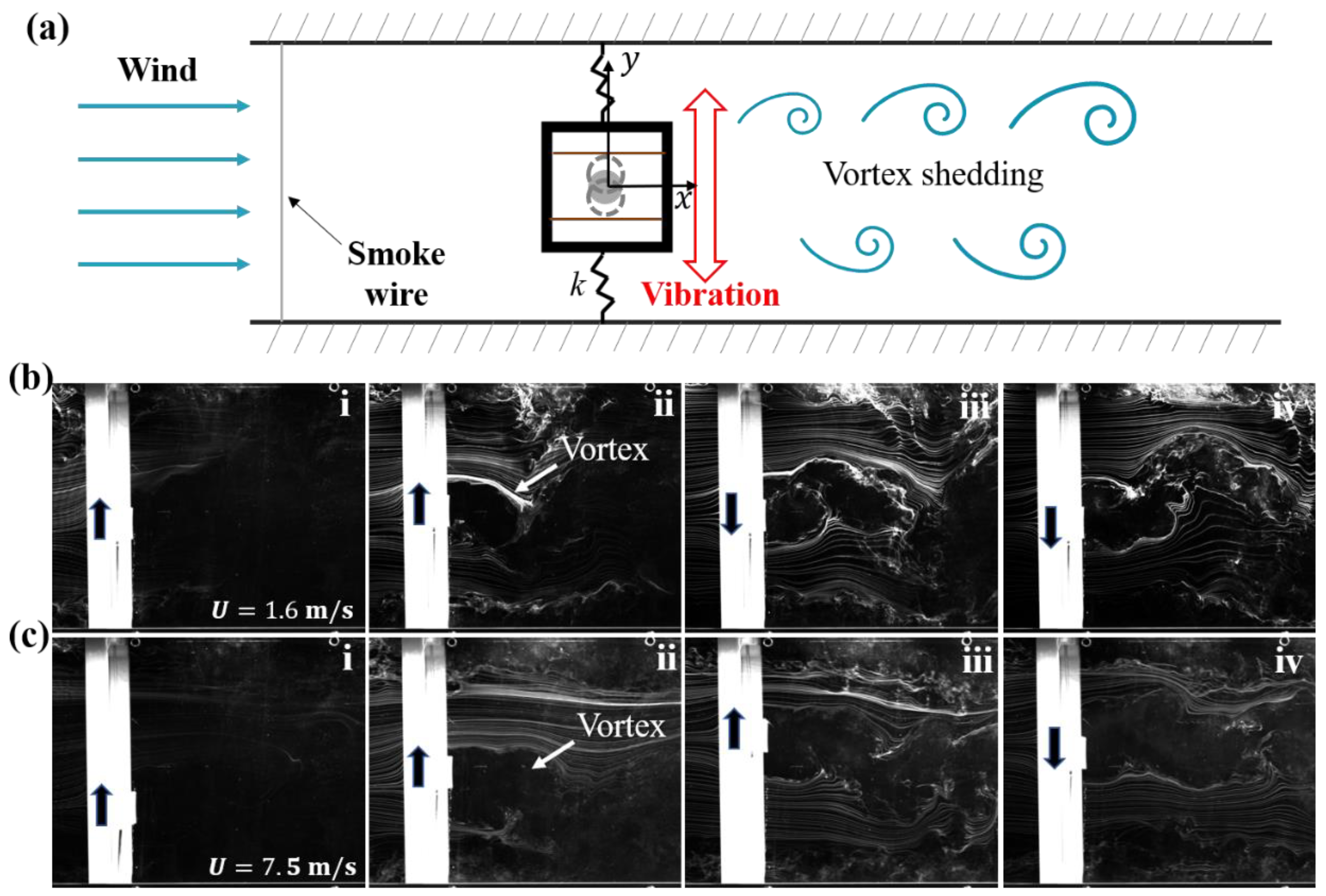
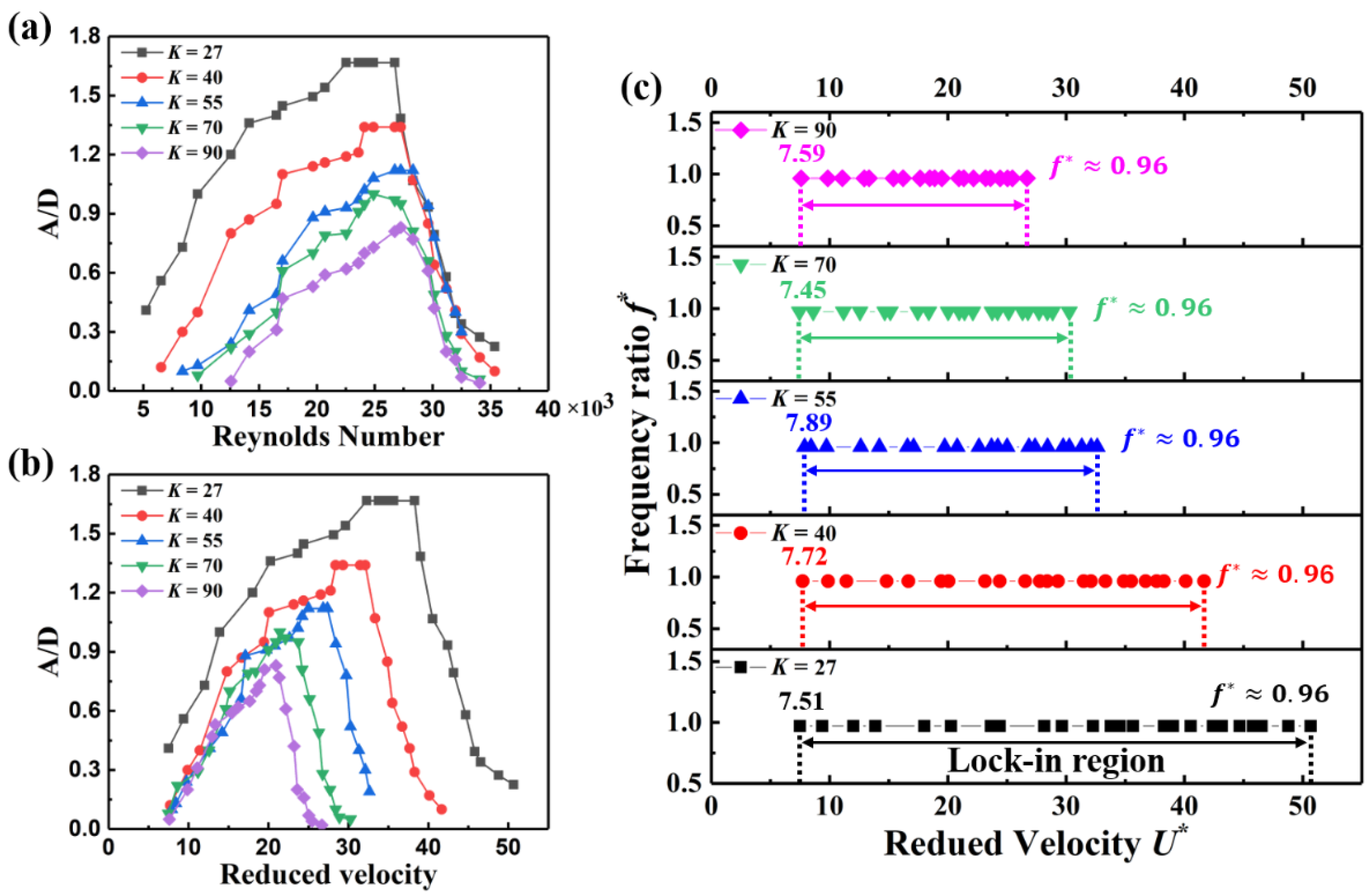
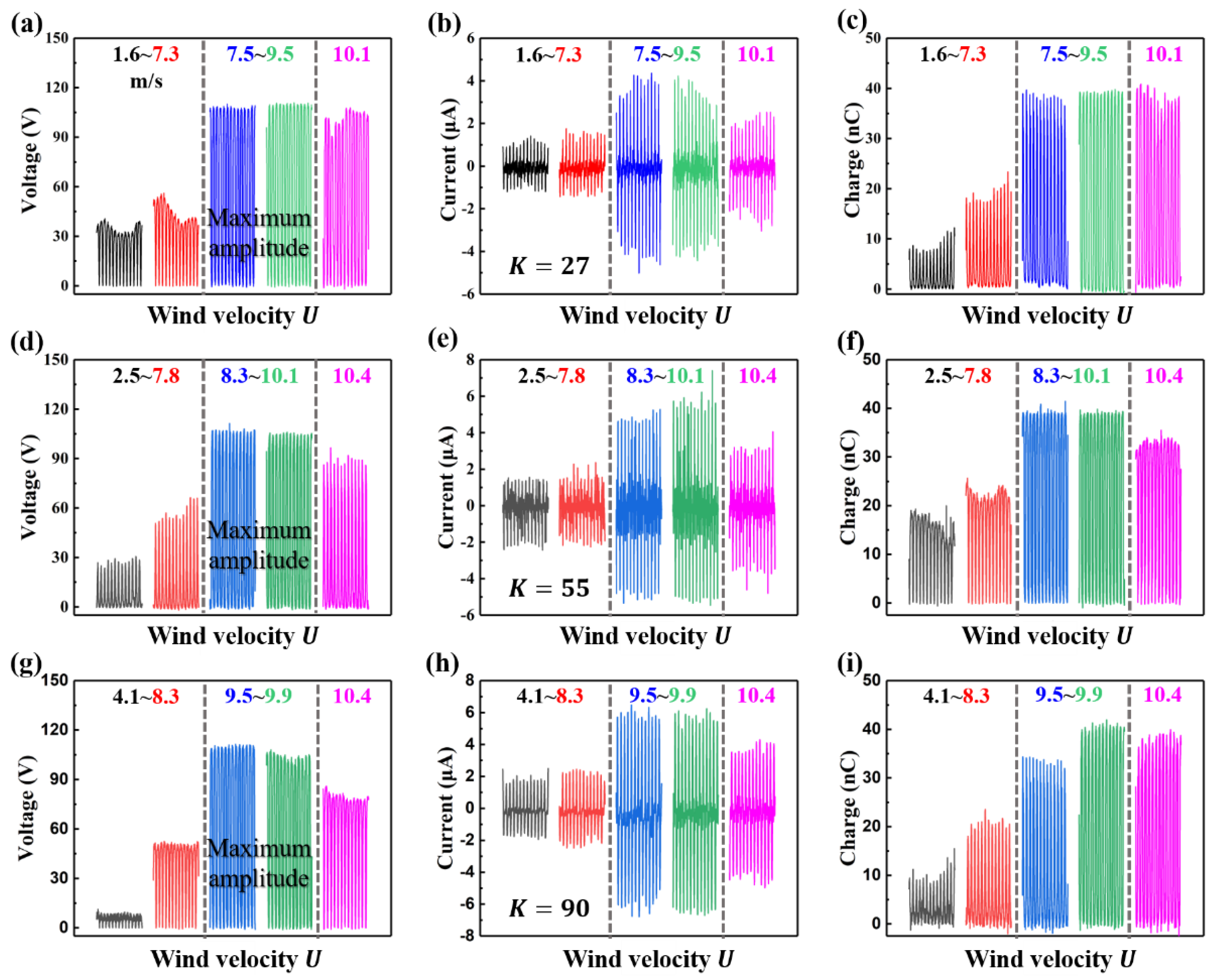
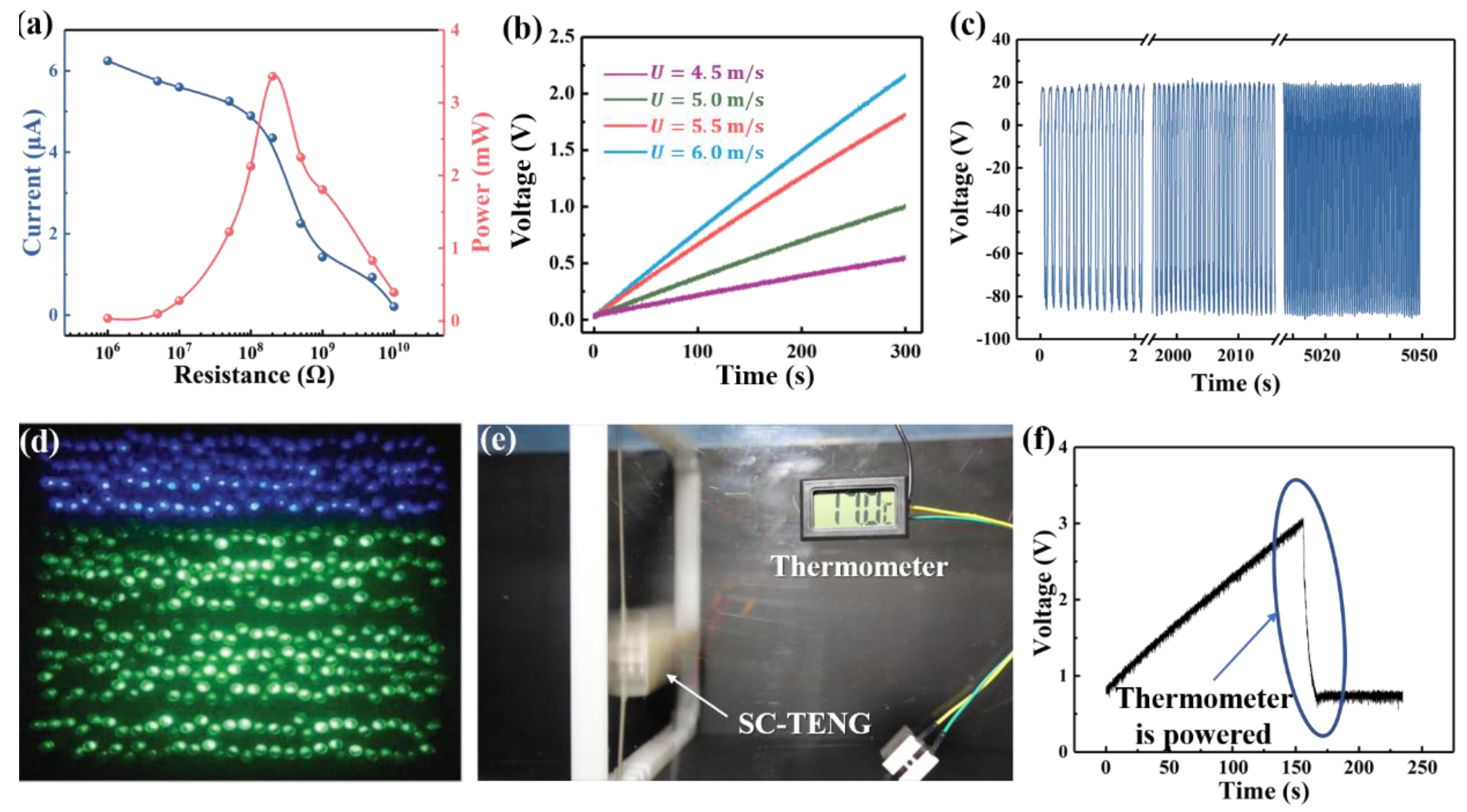
| Parameter | Symbol | Value |
|---|---|---|
| Length (mm) | ||
| Width (mm) | ||
| Height (mm) | ||
| Stiffness (N/m) | ||
| Mass ratio | ||
| Reynolds number | ||
| Damping factor |
| Case | 1 | 2 | 3 | 4 | 5 |
|---|---|---|---|---|---|
| Spring stiffness (N/m) | 27 | 40 | 55 | 70 | 90 |
| Natural frequency (Hz) | 8.9 | 10.8 | 12.7 | 14.3 | 16.2 |
| Working Mechanism | Device | Wind Speed (m/s) | Power Density (W/m3) | Ref. |
|---|---|---|---|---|
| Vortex-induced vibration | VIV-TENG | 12.4 | 62.2 | [38] |
| SC-TENG | 12.4 | 135.42 | This work | |
| Flutter driven structure | FTEG | 22 | 7.64 | [32] |
| TENG | 12 | 88.1 | [43] | |
| TENG | 14 | 1.16 | [44] | |
| TENG | Not given | 39.6 | [45] | |
| TENG | Not given | 58 | [46] | |
| Rotational structure | SR-TENG | 32.6 | 0.4 | [47] |
| a-TENG | 8 | 0.19 | [48] |
Publisher’s Note: MDPI stays neutral with regard to jurisdictional claims in published maps and institutional affiliations. |
© 2022 by the authors. Licensee MDPI, Basel, Switzerland. This article is an open access article distributed under the terms and conditions of the Creative Commons Attribution (CC BY) license (https://creativecommons.org/licenses/by/4.0/).
Share and Cite
Chang, Q.; Fu, Z.; Zhang, S.; Wang, M.; Pan, X. Experimental Investigation of Reynolds Number and Spring Stiffness Effects on Vortex-Induced Vibration Driven Wind Energy Harvesting Triboelectric Nanogenerator. Nanomaterials 2022, 12, 3595. https://doi.org/10.3390/nano12203595
Chang Q, Fu Z, Zhang S, Wang M, Pan X. Experimental Investigation of Reynolds Number and Spring Stiffness Effects on Vortex-Induced Vibration Driven Wind Energy Harvesting Triboelectric Nanogenerator. Nanomaterials. 2022; 12(20):3595. https://doi.org/10.3390/nano12203595
Chicago/Turabian StyleChang, Qing, Zhenqiang Fu, Shaojun Zhang, Mingyu Wang, and Xinxiang Pan. 2022. "Experimental Investigation of Reynolds Number and Spring Stiffness Effects on Vortex-Induced Vibration Driven Wind Energy Harvesting Triboelectric Nanogenerator" Nanomaterials 12, no. 20: 3595. https://doi.org/10.3390/nano12203595
APA StyleChang, Q., Fu, Z., Zhang, S., Wang, M., & Pan, X. (2022). Experimental Investigation of Reynolds Number and Spring Stiffness Effects on Vortex-Induced Vibration Driven Wind Energy Harvesting Triboelectric Nanogenerator. Nanomaterials, 12(20), 3595. https://doi.org/10.3390/nano12203595






